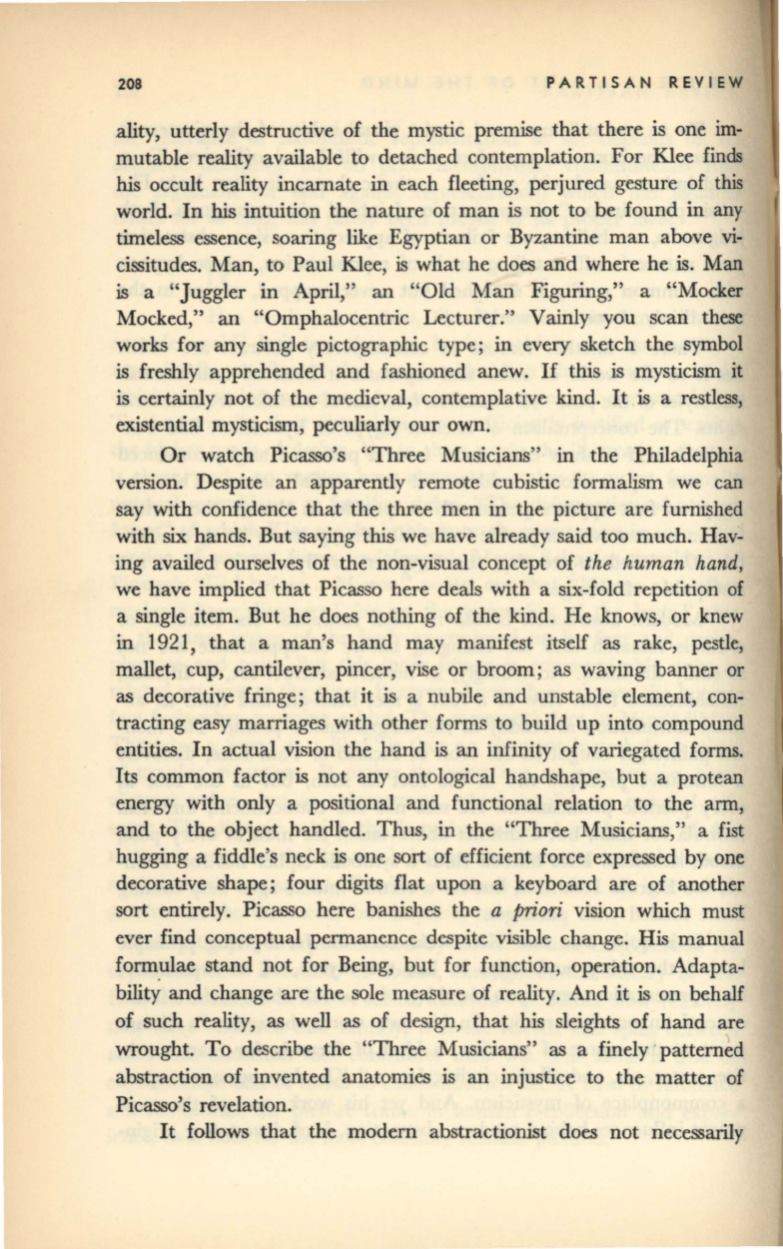
208
PARTISAN REVIEW
ality, utterly destructive of the mystic premise that there is one
im–
mutable reality available to detached contemplation. For Klee finds
his occult reality incarnate in each fleeting, perjured gesture of this
world. In
his
intuition the nature of man is not to be found in any
timeless essence, soaring like Egyptian or Byzantine man above
vi–
cissitudes. Man, to Paul Klee, is what he does and where he is. Man
is a "Juggler in April," an "Old Man Figuring," a "Mocker
Mocked," an "Omphalocentric Lecturer." Vainly you scan these
works for any single pictographic type; in every sketch the symbol
is freshly apprehended and fashioned anew.
If
this is mysticism it
is certainly not of the medieval, contemplative kind. It is a restless,
existential mysticism, peculiarly our own.
Or watch Picasso's "Three Musicians" in the Philadelphia
version. Despite an apparently remote cubistic formalism we can
say with confidence that the three men in the picture are furnished
with six hands. But saying this we have already said too much. Hav–
ing availed ourselves of the non-visual concept of
the human hand,
we have implied that Picasso here deals with a six-fold repetition of
a single item. But he does nothing of the kind. He knows, or knew
in 1921, that a man's hand may manifest itself as rake, pestle,
mallet, cup, cantilever, pincer, vise or broom; as waving banner or
as decorative fringe; that it is a nubile and unstable element, con–
tracting easy marriages with other forms to build up into compound
entities. In actual vision the hand is an infinity of variegated forms.
Its common factor is not any ontological handshape, but a protean
energy with only a positional and functional relation to the arm,
and to the object handled. Thus, in the "Three Musicians," a fist
hugging a fiddle's neck is one sort of efficient force expressed by one
decorative shape; four digits flat upon a keyboard are of another
sort entirely. Picasso here banishes the
a priori
vision which must
ever find conceptual permanence despite visible change. His manual
form~lae
stand not for Being, but for function, operation. Adapta–
bility and change are the sole measure of reality. And it is on behalf
of such reality, as well as of design, that his sleights of hand are
wrought. To describe the "Three Musicians" as a finely patterned
abstraction of invented anatomies is an injustice to the matter of
Picasso's revelation.
It follows that the modern abstractionist does not necessarily


